In the past you could invest in mid-term volatility, four to seven months out, without worrying too much about the erosive effects of contango. That’s not the case anymore. Strategies that hold long/short positions in mid-term and short term VIX futures as well as ETPs that hold mid-termVIX futures such as Barclays’ VXZ and XVZ and ProShare’s VIXM are getting dragged down.
Most of the attention in the volatility scene is focused on the 30-day VIX index and the short term VIX futures—the two futures months next in line to expire. Usually the longer term months are ignored, or used for hedging short-term positions against big volatility spikes. Historically unless the market is panicky the mid-term months tend to be in slight contango.
The chart below from VIX Central shows a typical term structure of VIX futures prices versus time when the VIX was around 16
- VIX Futures term structure 18-Mar-2010
Things have changed. The August 8th, 2012 term structure, with the VIX at 15.3 looks like this:
- VIX Futures Term Structure 8-Aug-2012
Comparing the two curves in the chart below we see that the 4th and 5th months are similar, but now the slope of the mid-term months is much steeper:
- VIX future term structure 2010 vs 2012
The mid-term slope in 2010 was 0.125 points per month, the 2012 number is 0.9 pts per month—seven times higher.
Contango on short term futures has been elevated since the 2008/2009, but the average levels have not peaked above the 2009 levels. The chart below shows short term contango expressed in the percentage monthly erosion you would expect if you held a short term position.
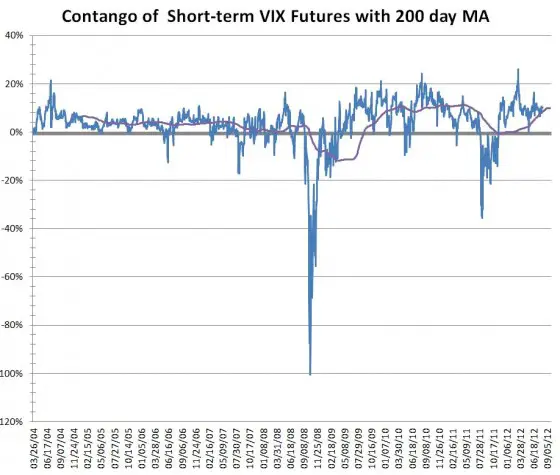
Mid-term contango, on the other hand ramped up in 2010/2011 and peak levels have jumped an additional 50% this year.
- Medium Term VIX Futures Contango 2004 to Present
A look at the CBOE’s VIX term structure chart below reveals that this steep term structure is also present in the VIX Index.
- CBOE VIX Index Term Structure
Since the VIX index just reflects implied volatility on SPX options, the shift in term structures must be present in SPX options also.
Since the SPX option market is considerably bigger than the VIX futures market I assume that the VIX futures are just tagging along—for reference the notional value of the 4th through 7th months of VIX futures is currently around $2.5 billion.
Historically mid-term volatility futures are in contango 75% of the time; a sustained increase in average contango from less than 2% per month up into the 3% to 4% range will unhinge a lot of hedging strategies. Not many schemes can survive that much extra loss.
If you are long medium-term volatility directly, or via an ETP you should reevaluate.

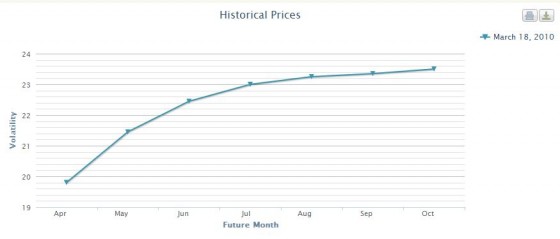
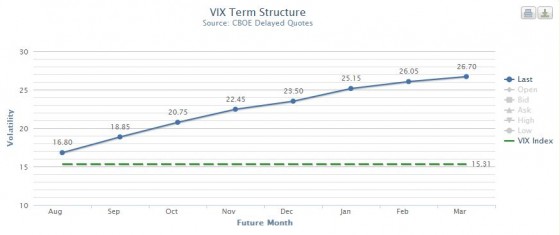
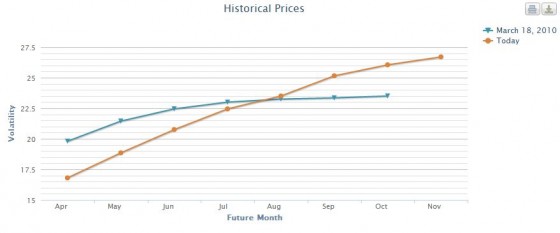
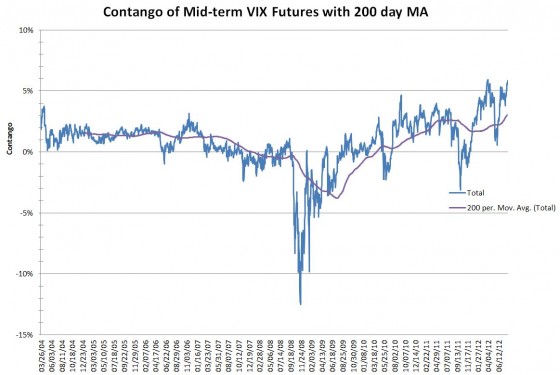
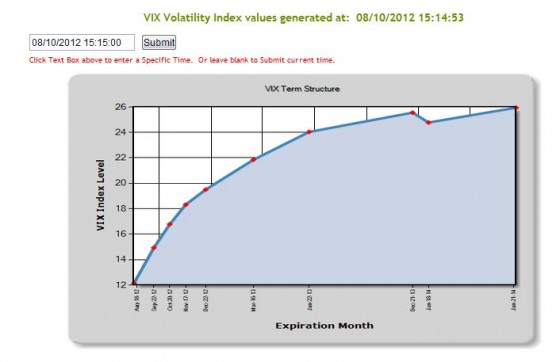
Are such extremes good leading indicators? Certainly I can see backwardation along the front months of the curve signifying a situation more likely to transition into contango, but what about extreme levels of contango? Do they typically transition into more “normal” levels?
Hi Peter, In general volatility measures don’t seem to be particularly good leading indicators.
Hi Vance – do you have an update on the mid-term contango, looks like the curve has flattened again recently? Thanks.
Hi Tarryn, Yes, the mid term slope has flattened out a bit but it is still in the 2% to 2.5% range–it was running around 3%. The gap between the VIX and the 7th month has been stable at around 5 so I think the 4,5,6 month premiums have been rising a bit.
— Vance
Questioin. Why not buy the ETF VXX that moves exactly with the Volatility Index? The options could expire and you loose money, so I cant see why anyone would buy them. Though with the etf VXX, if you hold it long enough, it seems like you cant loose money? We all know the Vix one day will hit 25 again, and then 40. So if you buy it low and hold it, how could you loose money on THE ETF VXX? Seems like a easy thing to average down on.
Unfortunately VXX does not move just like the VIX. Look at a 4 year chart–VXX is down way more than VIX. When the market is not panicky VXX loses around 7% a month due to yield roll issues.
— Vance
Great post. May I ask how you calculated the mid-term slope? e.g. in “The mid-term slope in 2010 was 0.125 points per month, the 2012 number is 0.9 pts per month—seven times higher’ what’s in the numerator and denominator? What’s the source of the data?
Thanks.
Hi jswift,
Thanks! I used vixcentral.com for the data/graph for March 18,2010 and Aug 13th, 2012. I didn’t give a slope, just the point different. The 2010 difference between the 4th and 7th month was 0.5 points, divided by 4 = 0.125. For 2012 the difference was 3.69/ 4 =.92. In terms of slope vixcentral computes them as 0.72% and 5.58% respectively. In general I use the VIX futures historical data available on the CBOE web site.
— Vance
Thanks! vixcentral has a nicer interface and its data seems to go back to 2008, whereas CBOE’s site stops at Nov 2010… I wonder if either set is available for download. I saw the downloads on the CBOE site but they are by year/month/contract and seem to require lots of alignment.
By the way, do you think the two dates you selected (3/18/10 & 8/13/12) are representative of their respective ‘eras’ or outliers?
Hi jswift, I’m not sure, but I think the CBOE micro-site you are referring to gives the VIX non-constant duration term structure (VIN, VIF, etc) not the VIX futures term structure.
I use the raw futures data from the CBOE site and integrate the 100+ spreadsheets into a single master spreadsheet that I use for analyzing this stuff. https://www.sixfigureinvesting.com/2010/12/volatility-futures-worksheet/
I’m confident the two dates are representative (during quiet times) of the old asymptotic structure and the current linear structure .
— Vance
Good stuff…. do you ever see abnomalities in the term structure before a big spike? are there good ways to hedge being short the term structure? meaning short the front month long the back.. is there a way to hedge blow out risk in the front month efficiently?
Hi Carey, Unfortunately I think the VIX term structure is like the VIX itself–no predictive value. What is very predictable is mean reversion after the spike has played out. Jumping in too soon is the main danger there.
I’ve never made the jump into VIX futures that would allow fine tuning the front vs further out months. Since the front month moves are so large OTM options might be the best approach to hedging. The 4-7th month area is interesting now because they have significant contango now and in a panic they historically have only gone into mild backwardation. Buying ZIV (inverse 4-7 ETF) might be a good way to short the term structure.
— Vance